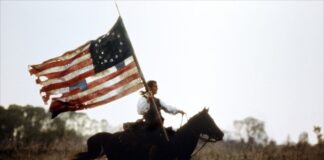A look back at how the absence of cynicism and brutality makes Mad Max: Beyond Thunderdome a humorous and emotional action classic.

George Miller almost single-handedly invented the modern post-apocalyptic action film, and the Mad Max saga belongs to the best that the genre has to offer. After his legendary masterpiece The Road Warrior he dialed the insanity level back just a little and created Mad Max: Beyond Thunderdome in 1985. Max Rockatansky’s third trip to the wasteland gave us a fresh perspective on the post-nuclear world, so let’s have a look!
Wasteland drifter Max (Mel Gibson) arrives in the settlement Bartertown to find his stolen car. Bartertown’s ruler Aunty Entity (Tina Turner) is in constant conflict with Masterblaster, the lord of the subterranean plant that provides energy for the surface dwellers. Max is coerced to solve Aunty’s problem by challenging Masterblaster to a lethal fight in the Thunderdome arena. After winning, he is betrayed and exiled to the desert. Max is rescued by a tribe of children who welcome him as their messiah, but he is drawn back to Aunty’s anger.
What’s a little fallout, eh?

The preliminary closure of the trilogy gives a more optimistic and humorous take on Max’s endeavors than the previous installments. Millers serves us a three-course menu that turns from campy action into an emotional journey and closes out with a fantastic car action finale. The sudden turns of mood and pacing may not appeal to viewers who expected another non-stop action masterpiece, but the film has a lot to offer beyond its action sequences.
Miller puts a strong focus on world-building and does it so convincingly that it became the template for dozens of copycats in the decades to follow. He fleshes out the world with incredibly detailed sets and fantastic cinematography that captures the proceedings against the backdrop of an epic desert landscape. The outrageous costume design with shoulder pads, mohawks and armor corsets became equally iconic and was imitated countless times.
Bartertown’s energy supply is provided by pig excrements from an underground facility. The city’s dependence on biogas draws obvious parallels to our society that is still powered by fossil fuels for the most part. So we might argue that business is going on as usual even after the big war. And yet Auntie’s rule has not created an evil society, but her hard rules for a hard world have enabled Bartertown to thrive to some extent.
Ladies and gentlemen, boys and girls: Dying time’s here!

The alternative concept is the tribe of children, who are depicted as noble savages with a cargo cult, and Max is destined to be their savior. After being forsaken by the adults, the adolescents are given a chance to be truly free and build a society devoid of aggression and not corrupted by technology. These two approaches both work in their own ways, even though they require different types of attitudes, and the children’s society may lend itself better to bring actual peace of mind to its inhabitants.
Tina Turner oozes an incredible amount of charisma and brings a lot of energy to the film. She will win you over in an instant, and we instantly forgive her any fits of malice she occasionally has. Gibson’s Max also loosens up a bit compared to the previous films. He talks more and even rediscovers his emotions when he starts to care for the children. And there’s plenty of memorable and fun characters in the film besides its two main stars. The action is more playful and significantly less brutal than in the previous films, which is in line with the overall more mellow presentation. There are two major set pieces: the Thunderdome fight and the essential car assault sequence towards the end of the film.
Thunderdome: Two men enter, one man leaves
Thunderdome has found its way into the pop culture canon with its iconic call to battle and Masterblaster, a brain and a brawn melded into a single terrifying creature. The scene takes movie cage fights to a new level thanks to Miller’s stroke of genius to create a semi-spherical arena where the contestants swing through the air strapped to rubber bands, with a raving audience covering the fences, and deadly weapons placed in the arena ready for taking.
Max’s return to Bartertown from exile also brings back the action and shows how Auntie’s project literally is built on a volatile basis. After demolishing the underground plant, Mad and his crew hijack an old train with the motorized Bartertown motor pool on their heels. Miller demonstrates again that he is a master of car action when the train is besieged at 50 mph. It’s a fantastic sequence with the adrenaline level cranked to the maximum, and occasionally just as perilous for the stunt crew as in the Road Warrior.
The absence of cynicism and brutality makes Mad Max: Beyond Thunderdome a rare entry to the post-apocalyptic action genre. Miller created an often humorous and emotional tale that became an eternal classic just like all other installments of the movie series.








